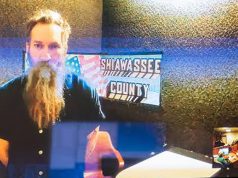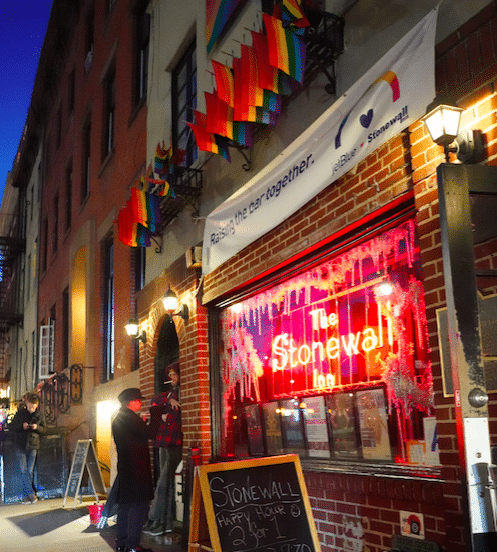
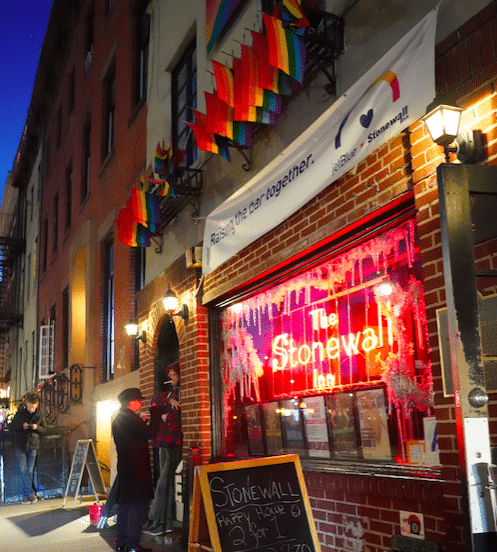
Erica Snyder, 21, is a visual storyteller who spent March photographing patrons at Stonewall Inn to celebrate the 50th anniversary of the riots that helped trigger the equality movement. Here Erica narrates her photos for Queerty.
You probably heard about Madonna and Taylor Swift giving special performances at the bar to celebrate WorldPride.
But the reality is that for the last 52 years (yes, it was founded two years before the riots took place), it’s been home to an assortment of regular people seeking some combination of love, sex, community and just plain fun.
I am a lesbian who turned 21 last July, and Stonewall has become my go-to bar as soon as I became legal. It’s a place where I can go with my friends on a Friday night while also meeting other members of the community. But after spending time there, I realized the bar had a far richer history than I understood and I learned what makes Stonewall, Stonewall – the people. A bar is only as special, is only as accepting, as those who patronize it. Stonewall’s not Stonewall without those inside the double doors who line the bar, dance the night away and wait in line for the all-gender bathrooms…
After night one of this project, I made the creative choice to photograph on a small point-and-shoot versus my larger mirrorless camera. It allowed me to remain unobtrusive in the space in a way I couldn’t do with my mirrorless camera. And sure, the photos are grainier; and sure, they’re lower quality. But there’s an authenticity to them that’s consistent with the style and history and patrons of this fabulous queer space.
As a visual storyteller, my hope is to document – and continue documenting – the stories of the LGBTQ community. Right now, I’m working on another project, The Queer Couple Project, in hopes of showing different kinds of queer relationships, with a focus on trans, non-binary, and female-identifying members. The long-term goal of the project is to create an interactive digital map where people can view how geography and culture influence queer relationships.
I do love photographing at Stonewall and continuously learning about the people who cherish it – they’re made to be documented.
52 years ago, the bar opened its doors for the very first time, evolving from restaurant to gay-oriented bar that quickly gained a following because it permitted dancing. At the time, no other gay bar permitted its patrons to dance because they could be subject to arrest. Stonewall’s Mafia-affiliated owners spent $1200 keeping the police at bay and out of sight, giving its customers a faux sense of comfort while patronizing the club. The truce lasted only so long. In June 1969, almost 50 years ago, police harassment finally went too far. Patrons furious at yet another raid on the sanctuary fought back, blowing up into what we know today as the Stonewall Riots or Uprising.
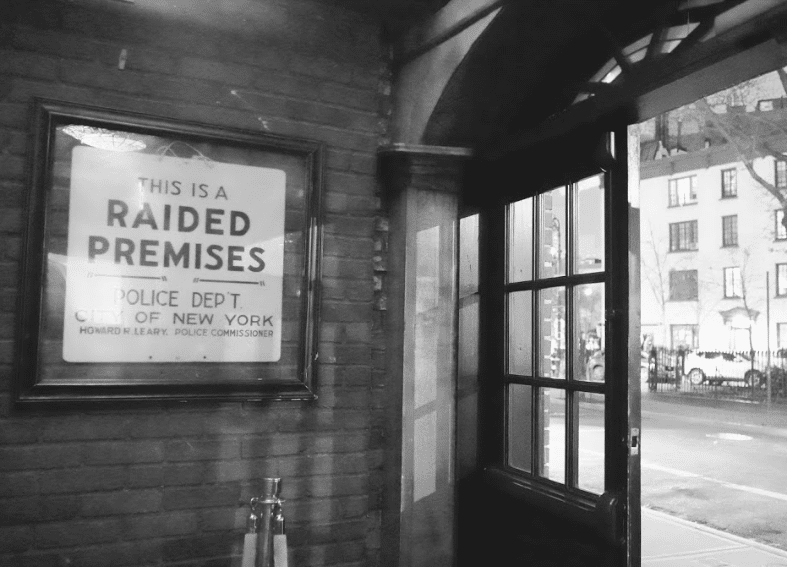
Since then, the landscape of the bar has changed while also sticking to its core belief: providing a safe space for the community. The photo above was taken on a quiet evening in the bar, right after work. People caught up with friends over a quick drink, and it was quiet enough to easily converse. It felt peaceful, harmonious – the thought that police raided this same place years before seemed foreign and almost absurdly impossible based on the progress we have made.
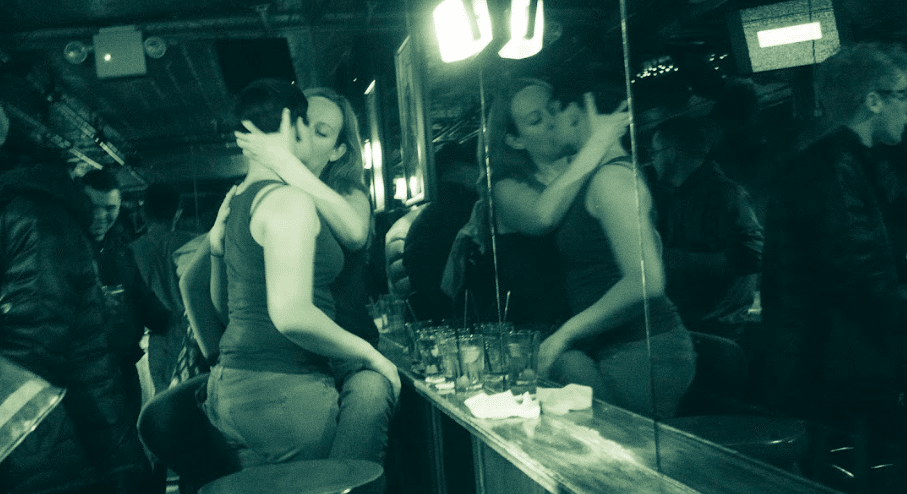
But Instead of functioning as a safe haven for a select few like many bars do, Stonewall Inn functions as a welcoming, safe place for everyone while still paying homage to its roots. On a Friday night, a remarkably diverse people of various ages, races, sexual orientations, and genders, fill the bar – and showing off their love.
During the night where these women kissed in the mirror, Stonewall was packed and love was in the air. I was immediately drawn to this couple. Their interaction felt so intimate and yet so normal. The left side, the reality side, is symbolic of the type of intimacy that occurs in Stonewall regularly, but the emotion seen on the face via the mirror feels distinct. They’re a distinct couple, absolutely, but also part of the larger harmonious community of the space.
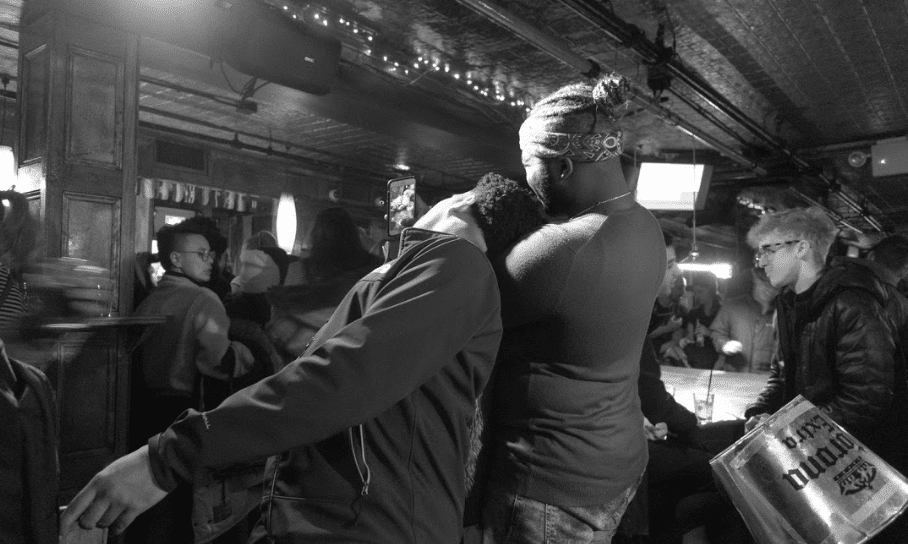
As a photographer, I was fascinated that these guys really wanted to photograph themselves in the space. There was no shame, only pride. Fifty-two ago, patrons would’ve never have taken photos in a gay bar. In fact, they would be wearing caps pulled down over the faces and enter a space with blacked-out windows to the street. Today, people want to be photographed at a Stonewall bar and blast it all over their social media. They are proudpatrons, and that is worth documenting.
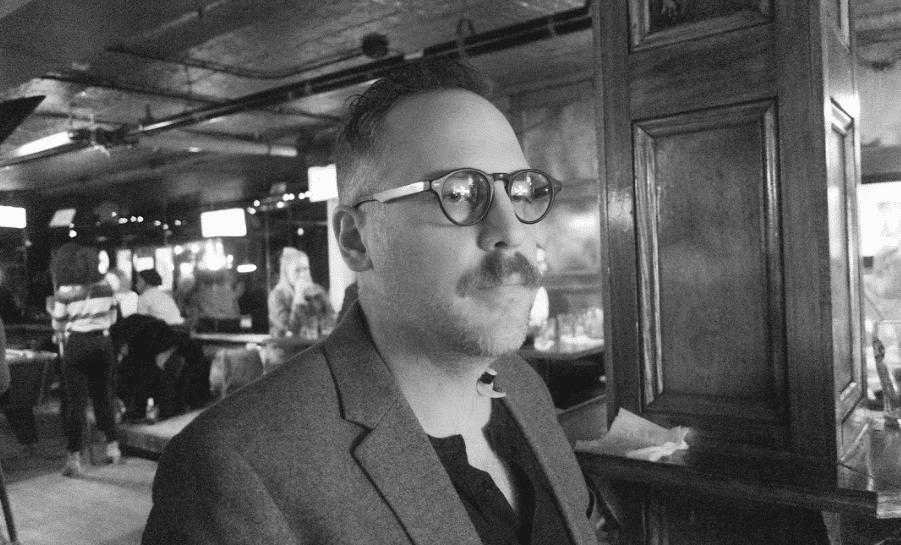
Brad first walked into Stonewall in 1997, almost 30 years after the Stonewall Riots and in the midst of the HIV/AIDS crisis.
In 1997, Brad explained that those who visited Stonewall visited for the rich history of the bar. Nowadays, not so much. “Now, they don’t even know the history of it,” he said. During that time, Brad described his sex life as “promiscuous” but eventually met his current husband David. Early into their hooking-up phase, David found out he contracted HIV.
“HIV virus is a nasty little bitch,” Brad said. “[David] found out when we were together and had a super huge viral account. But me, nothing. I thought I’m a goner. But nothing. I’m on PrEP now, obviously.” Brad remains HIV negative.
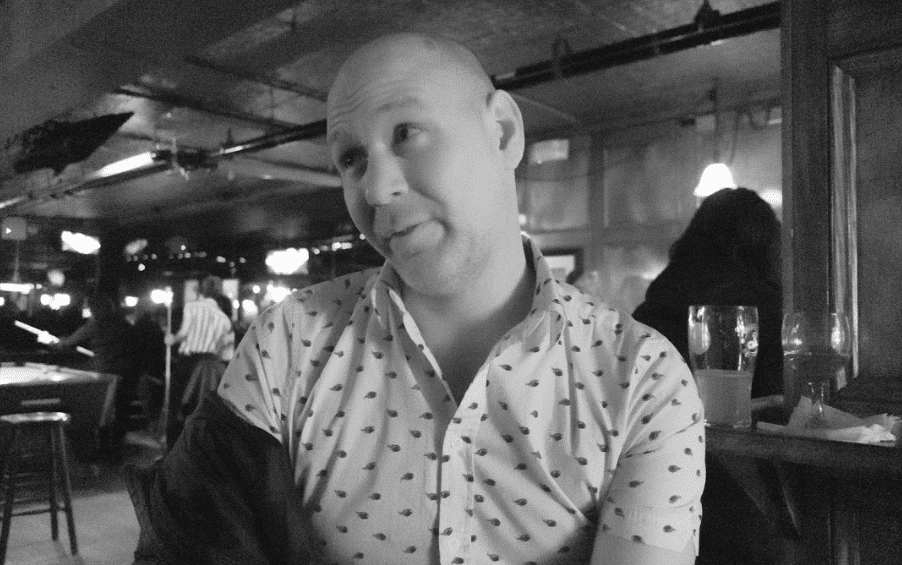
Regardless of his HIV status, David, Brad’s husband, emphasized that it really “does get better… I’m sure there a lot of young men and women who are having a hard time, but there’s always a place for everybody. Just be yourself and live your life,” he said. “My brothers were assholes to me and now they LOVE me.”
It took them a while to come around, to accept him for who he is. After treating him as an outsider for so long, they now accept him for who he is and love him and his husband dearly.
David and Brad are in the process of moving back to New York City from Austin because regardless of the love-hate relationship most have with New York City.
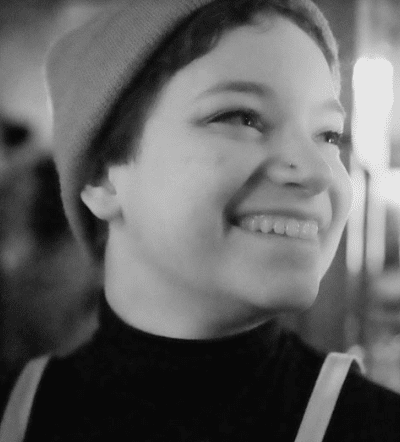
For young lesbians like Emilee, 23, Stonewall provides an accepting environment as well as a way to actively meet other LGBTQ people like her, and not always for dating. On this night, Emilee sipped her drink alone, casually leaning against a pole toward the middle of the room.
Usually, Emilee drags her straight friends to Stonewall, but that night she did not come with a group and hoped to find a friend before the evening ended. She did. His name: Winter Matthew Charles Brower IV (below)
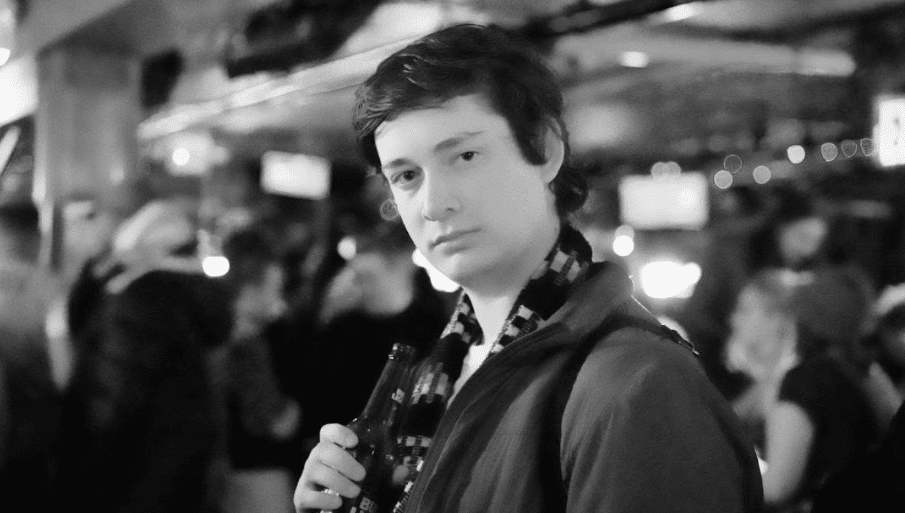
That night was Matthew’s first night at Stonewall, and he very much relished in the novelty of the bar, observing all the surrounding stimuli and the community in it.
He described his first night at Stonewall as “fantastic,” as it led to important insights into his own gender expression and sexual orientation. “Am I pansexual? Am I gay?” he asked. “I am struggling. Pronouns confuse people. Am I she? Am I he? Everyone needs to be treated with respect. When you look into each other’s’ eyes, that’s each other’s souls.”
Matthew left before finishing his beer and bid goodbye Emilee but guaranteed this would not be his last time at Stonewall to see her again and for further exploration.

While Stonewall provides a place for the community to simply be, it also fosters an environment where parents – yes, parents – can connect with their children in a queer place. who is this? where are parents?
Sally, a middle-aged suburban mom, had never visited the historic Stonewall before. She ventured into the bar to watch her son perform drag for the first time – and braved a Stonewall-sized vodka tonic before the show began. “You can feel the history here,” she said.
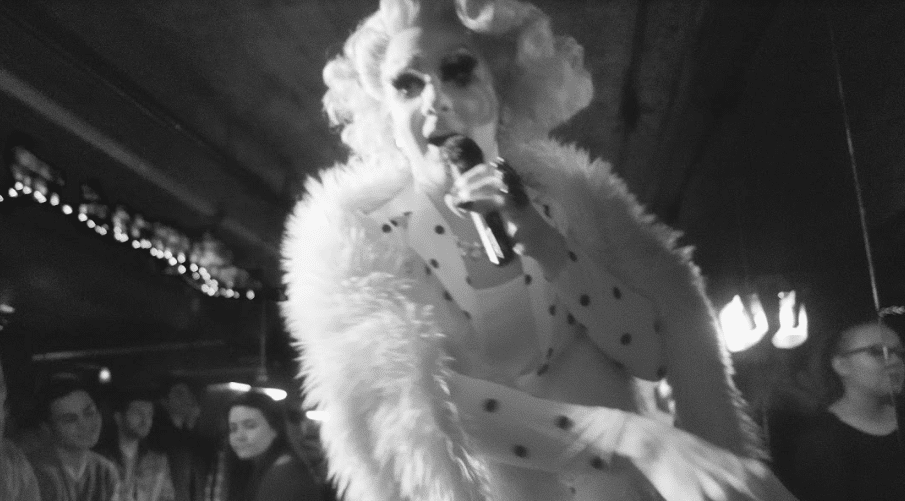
Sally’s son, Vanna Deux, a New York City drag queen, sang live for 2 full hours that night. And Vanna killed it, giving Robyn some fierce competition with her rendition of “Dancing on my Own.”
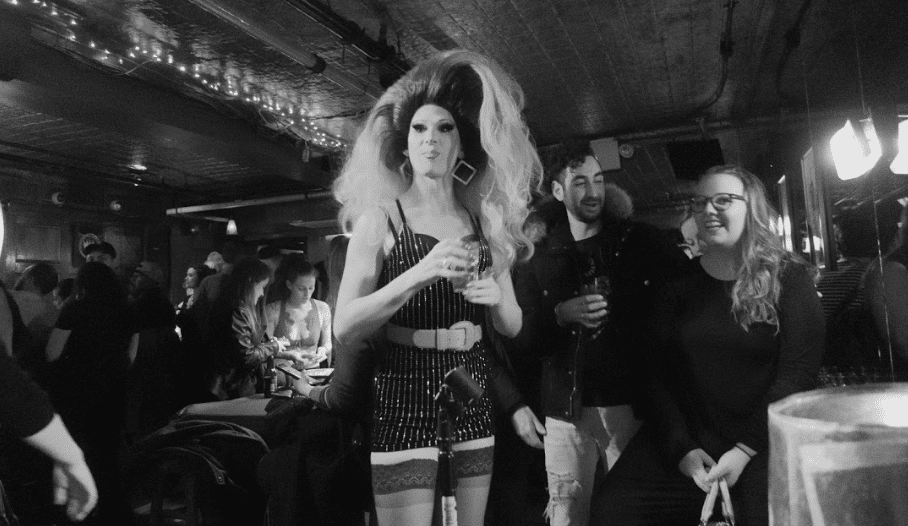
From moms and drag queens to middle-aged gay men and freshly out queer young adults, Stonewall welcomes everyone for whoever they are and whoever they want to be. And of course, whomever they want to love.
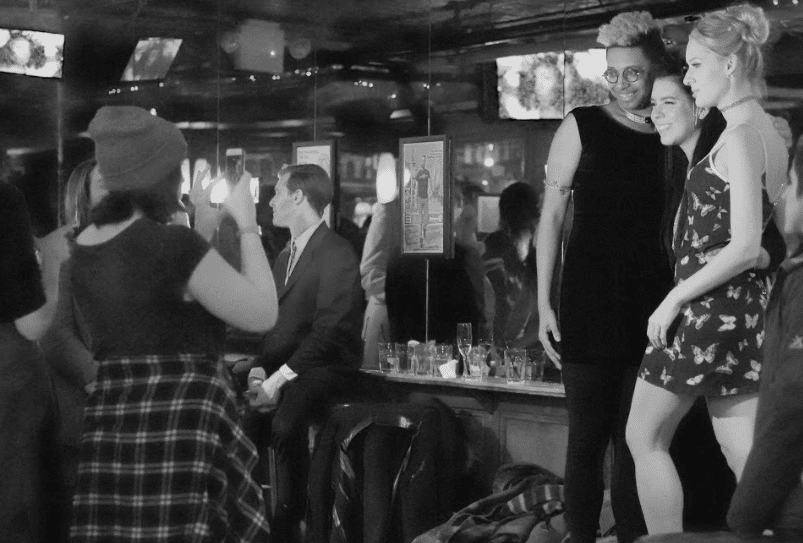
Happy 52nd birthday, Stonewall.







